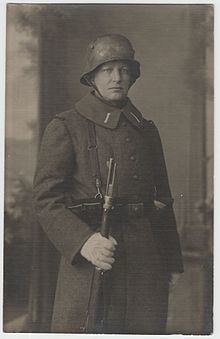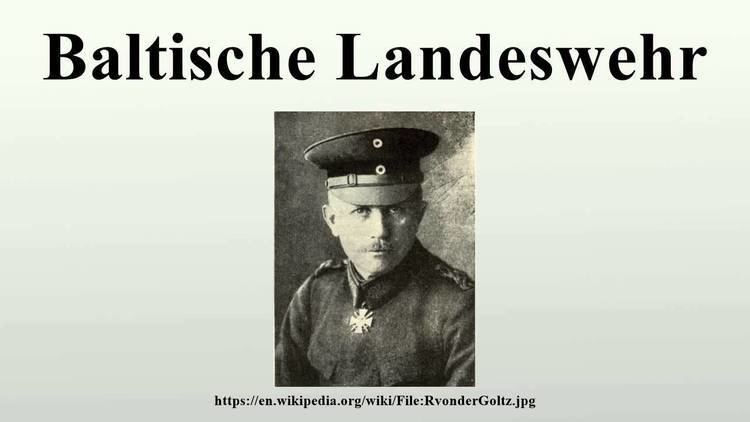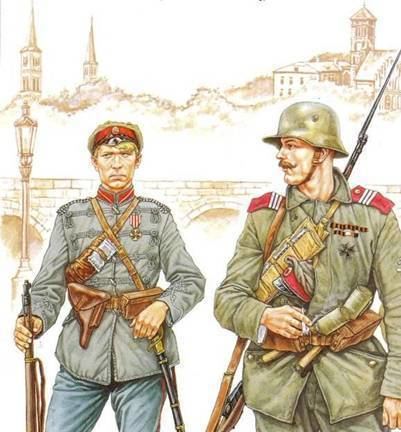March Goose-Step | Size 10,500 | |
 | ||
Active November 1918 - January, 1920 Notable commanders Rüdiger von der Goltz, Harold Alexander, 1st Earl Alexander of Tunis, Alfred Fletcher Similar Freikorps, Estonian Land Forces, Estonia Defence Forces, Latvian National Guard, Volunteer Army | ||
Baltische landeswehr
The Baltic Landwehr or Baltische Landeswehr ("Baltic Territorial Army") was the name of the unified armed forces of the Couronian and Livonian nobility from 7 December 1918 to 3 July 1919.
Contents
- Baltische landeswehr
- Command structure
- Commanders
- History
- Theaters and Campaigns
- Subsequent
- Prominent members
- Insignia
- Order of battle 20 May 1919
- References

Command structure
The Landeswehr was subordinated to the German VI Reserve Corps commanded by Rüdiger von der Goltz, a position he gained on 1 February 1919. The commander of the Landeswehr during its operations was Major Alfred Fletcher and Harold Alexander.
Commanders

History

After the November 11, 1918, armistice the Inter-Allied Commission of Control insisted that the German troops remain in the Baltic countries to prevent the region from being re-occupied by the Red Army. As the Soviet westward offensive of 1918–1919 approached, the Provisional Government of Latvia approached August Winnig, the German attorney in the Baltics, and signed an agreement with him authorising the organisation of land defense forces on 7 December 1918. The parties signed another agreement on 29 December which secured all foreign soldiers, who participated in the battles for the freedom of Latvia, full citizenship of Latvia. The arms, horse harness and uniforms were to be supplied by the state of Germany. The food supplies were to be taken care of by the Provisional Government of Latvia.
Theaters and Campaigns

In late February 1919 only the seaport of Liepāja (Libau) and surroundings remained in the hands of the German and Latvian forces. In February and March 1919, the Landeswehr was able to win a series of victories over the Red Army, first occupying the port of Ventspils (Windau), and then advancing south and east towards Riga. The murder of three men of the Baltische Landeswehr led to the coup d'état of April 16, 1919, by the proclamation of the Government of a Lutheran clergyman, Andrievs Niedra. Parleys, in which the United States and the United Kingdom took part, did not prevent the advance on Riga and the capture of this city on May 22, where Baron Hans von Manteuffel made an entry with a small detachment, and died leading his men. Latvian national government was deposed while the Freikorps moved on to capture Riga on May 23, 1919. Latvians sought assistance from the Estonian Army which had been occupying Northern Latvia since earlier that year. After the Bolsheviks had been driven out from most of Latvia, the Allies ordered the German government to withdraw its troops from the Baltic region. However, the Germans succeeded in negotiating a postponement, arguing that this would have given the Bolsheviks a free hand. In June 1919, General von der Goltz ordered his troops not to advance east against the Red Army, as the Allies had been expecting, but north, against the Estonians. On June 19, the Landeswehr launched an attack to capture areas around Cēsis (Wenden), however in the battles over the following few days they were defeated by the Estonian 3rd Division, including the Latvian 2nd Cesis regiment, led by Ernst Põdder. On the morning of June 23, the Germans began a general retreat toward Riga. The Allies again insisted that the Germans withdraw their remaining troops from Latvia and intervened to impose a ceasefire between the Estonians and the Landeswehr when the Estonians were about to march into Riga. In the meantime, an Allied mission composed of British troops under General Sir Hubert de la Poer Gough had arrived in the Baltic with the task of clearing the Germans from the region and organizing native armies for the Baltic States. To ensure its return to Latvian control, the Baltische Landeswehr was placed under British authority.
Subsequent

After taking command of the Baltische Landeswehr in mid-July 1919, Lieutenant-Colonel Harold Alexander (the future Field Marshal the Earl Alexander of Tunis and Governor General of Canada, 1946-1952), gradually dismissed German nationals born within the borders of Imperial Germany.
The Germans released from the Baltische Landeswehr were incorporated into the Deutsche Legion in September 1919. The legion served under the West Russian Volunteer Army commanded by Colonel Prince Pavel Bermondt-Avalov in his attempt to capture Riga, but suffered complete defeat by the end of November 1919.
The British insisted that General von der Goltz leave Latvia, and he turned his troops over to Bermondt-Avalov's West Russian Volunteer Army. General von der Goltz later claimed in his memoirs that his major strategic goal in 1919 had been to launch a campaign in cooperation with the white Russian forces to overturn the Bolshevik regime by marching on Saint Petersburg and to install a pro-German government in Russia.
The purged Baltische Landeswehr units subsequently assisted in the liberation of Latgale from Bolsheviks together with Latvian and Polish armies in January 1920.
Prominent members
Prominent Baltic officers from the Landeswehr era include:
(the ranks are the highest ranks reached in the Third Reich era)
Insignia
Members of the Baltische Landeswehr wore shoulder strap piping in light blue and white, the Baltic colors.
